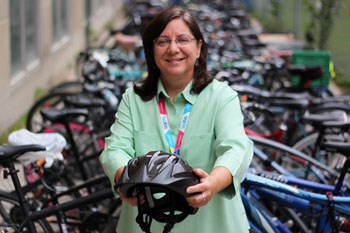Why I care what your child wears on their head!
Summary:
Dorothy McDowall, Trauma Patient Care Coordinator at SickKids, discusses the importance of wearing a bike helmet.
Dorothy McDowall is the Trauma Patient Care Coordinator at SickKids. She is also a member of the Toronto Helmet Initiative (THI) which is a group of not-for-profit organizations dedicated to reducing head injuries and promoting physical activity. The partners for this initiative are: SickKids, Toronto Catholic District School Board, Toronto District School Board, Toronto Police Service and Toronto Public Health.

As the Trauma Patient Care Coordinator at SickKids, I really do care what your child wears on their head. For over a quarter of a century, I have cared for children who have had traumatic brain injury as a result of being in a collision while riding a bike. Many of these children were wearing improperly fitted helmets or no helmets at all. Statistics show that 4 out of 5 traumatic brain injuries could be avoided with properly fitted helmets. Parachute Canada tells us that brain injuries are the number one cause of serious injury and death for children on bicycles.
Brain injuries cause changes, sometimes permanently, to a child’s ability to think, speak and move their bodies. It is heartbreaking to work with patients and families who have had their lives suddenly altered as a result of a traumatic brain injury; especially one that could have been prevented.
For this reason, our Trauma Program has been a part of a new group called the Toronto Bike Helmet Initiative, which includes agencies who also care about what your child wears on their head! The goal is to have all children wearing appropriately fitting bike helmets. We are demonstrating this using the 2-V-1 rule which means the edge of the helmet should be 2 fingers from forehead; straps should meet in a V-shape just below the ears; one finger should fit between the chin and chin straps; it should not shift around more than an inch in any direction.
This isn’t just about your child. You, as a parent, can make a major impact by being an adult role model who wears your helmet when you are on a bike, or when riding anything with wheels. Children need to see adults; their parents and grandparents, teachers and coaches wearing helmets. Practicing good role modeling and starting this habit when they are young, even while on a tricycle, sets them up for important lifelong safety habits.
![]() For more information about the Toronto Helmet Initiative please visit www.toronto.ca/helmets and share with your friends and family too! You can also download this helpful poster about the 2-V-1 Rule (PDF)
For more information about the Toronto Helmet Initiative please visit www.toronto.ca/helmets and share with your friends and family too! You can also download this helpful poster about the 2-V-1 Rule (PDF)

